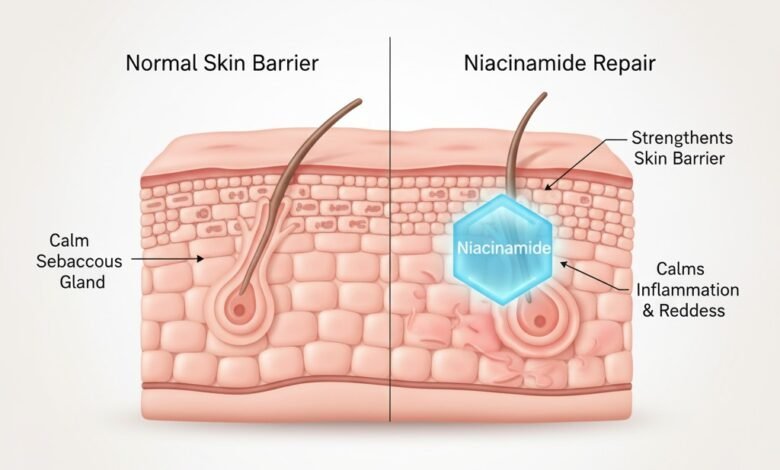Niacinamide for Acne-Prone Skin: A Complete Guide to How It Works, Dosage, and Product Combinations

In the vast ocean of skincare active ingredients, Niacinamide, or technically known as Vitamin B3, stands out as one of the most versatile and scientifically proven ingredients. Its popularity is not without reason, especially for those struggling with acne. However, to truly harness its power, we need to understand more than just its “benefits.” We need to dissect ‘why’ and ‘how’ it works at a cellular level.
At Salwa Salon, we believe that education is the foundation of healthy skin. Let’s delve deeper into the working mechanisms of Niacinamide, distinguishing it from merely a trend to a strategic asset in your acne-prone skincare routine.
What Exactly Is Niacinamide and Why Is It So Fundamental?
Before discussing its role in addressing acne, it’s important to understand Niacinamide’s position in skin biology. Niacinamide is the amide form of Vitamin B3, an essential water-soluble vitamin. Our bodies cannot store it in large quantities, making topical application (through skincare) highly effective.
Its fundamental role is as a precursor to important coenzymes—nicotinamide adenine dinucleotide (NAD+/NADH) and nicotinamide adenine dinucleotide phosphate (NADP+). These coenzymes are the “fuel” for over 400 biochemical reactions in our cells, including cellular respiration, DNA repair, and maintaining cell integrity. When applied to the skin, Niacinamide provides the raw materials for skin cells to function optimally. This is the basis of all the benefits we will discuss.
Three Key Mechanisms of Niacinamide in Addressing Acne: A Scientific Review
Acne is a multifactorial skin condition involving excessive sebum production, inflammation, and skin barrier dysfunction. Niacinamide uniquely targets all three pillars of these problems simultaneously. Here’s how it works in detail.
- Sebum Production Regulation: More Than Just Drying Out the SkinMany anti-acne products work by “drying out” surface oil, which is often temporary and can trigger irritation. Niacinamide’s approach is much smarter and more fundamental. Clinical studies have shown that topical Niacinamide application can significantly reduce the rate of sebum excretion and decrease levels of triglycerides and fatty acids in sebum.How does it do this? The exact mechanism is still being researched, but the strongest theory is that Niacinamide helps normalize and balance the activity of the sebaceous glands. It doesn’t shut them down; rather, it “reminds” the glands not to overproduce. The result is skin that appears less oily, not skin that feels dry and tight. This is a crucial difference that maintains long-term skin health.
- Anti-Inflammatory Action: Soothing Redness and IrritationInflamed acne (papules and pustules) is essentially the body’s immune response to P. acnes bacteria and clogged pores. Niacinamide possesses strong and proven anti-inflammatory properties.How does it do this? Niacinamide works by inhibiting the activation of nuclear factor-kappa B (NF-κB), a protein complex responsible for releasing inflammatory signals (pro-inflammatory cytokines) such as Interleukin-8 (IL-8). By suppressing these signals, Niacinamide effectively reduces the redness, swelling, and pain that often accompany acne. This makes it comparable to topical antibiotics like Clindamycin in terms of reducing inflammation, but without the risk of antibiotic resistance.
- Skin Barrier Reinforcement: The Foundation of Skin DefenseThis is perhaps Niacinamide’s most fundamental and impactful benefit. A damaged or weak skin barrier (stratum corneum layer) is an open door to skin problems. It cannot retain moisture (leading to dehydration) and cannot protect itself from external aggressions like bacteria and pollutants.How does it do this? Niacinamide directly stimulates the synthesis of key components of the skin barrier. Specifically, it increases the production of:
- Ceramides: Essential lipids that fill the spaces between skin cells, acting like “cement” that holds the “brick” cells together.
- Free Fatty Acids: Other important components of the lipid matrix.
- Cholesterol: Helps maintain barrier fluidity and structure.
By strengthening this “cement,” Niacinamide significantly reduces Transepidermal Water Loss (TEWL) and improves skin resilience. For acne-prone skin, a healthy barrier means the skin is better able to fight bacterial infections and is less easily irritated by other anti-acne active ingredients.
Practical Guide to Using Niacinamide for Maximum Results
Understanding the science behind it is one thing; applying it correctly is the key to success. Here’s our practical guide.
What is the Right Concentration?
Higher is not always better. For most benefits, including anti-inflammatory and barrier strengthening, concentrations of 2% to 5% have been proven highly effective with a very low risk of irritation. This concentration is ideal for beginners. For more specific targets like significantly reducing sebum or addressing skin texture, a 10% concentration can be used. Above that, the potential for irritation may increase without proportionate added benefits.
Synergistic Combinations: What Does Niacinamide Work Best With?
The beauty of Niacinamide lies in its ability to work well with other active ingredients.
- With Hyaluronic Acid: A classic combination for hydration and barrier repair. Hyaluronic Acid draws water, while Niacinamide locks it in by strengthening the barrier.
- With Salicylic Acid (BHA): BHA cleanses pores from within, while Niacinamide soothes inflammation and controls sebum. Apply BHA first, wait a moment, then follow with Niacinamide.
- With Retinoids: Retinoids accelerate cell turnover, while Niacinamide helps reduce the potential for retinoid irritation and strengthens the skin barrier. This is a very powerful pairing for anti-aging and anti-acne.
Important note regarding Vitamin C: The old myth stating that Niacinamide and Vitamin C should not be combined has now largely been debunked. Modern formulations are much more stable. However, if you have very sensitive skin, the safest approach is to use Vitamin C in the morning and Niacinamide at night.
Conclusion: Niacinamide as a Long-Term Investment for Your Skin
Niacinamide is not just a “trend” active ingredient for acne. It is a fundamental regulator that intelligently works to balance, soothe, and strengthen the skin from within. With its ability to control sebum without drying, calm inflammation at a cellular level, and rebuild the skin’s defensive foundation, Niacinamide deserves a permanent place in your skincare routine.
Understanding it as a long-term partner, rather than an instant solution, is the first step towards healthier, more balanced, and resilient skin.






